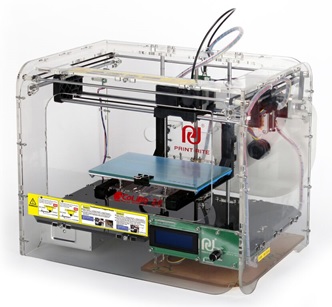
The ColiDo 3D Printer from Print-rite
3D printing is not as new as it might sound. It’s been around since the 1980s when the first patent was filed in Japan in May 1980 for “Rapid Prototyping Technology” (RPT) in order to try to create a faster method of
creating industrial prototypes. 1989 saw the introduction of the Fused Deposition Modelling technique (FDM) which is the method of 3D printing used by the CoLiDo machine.
Firstly, the object is designed by yourself on your computer and transmitted to the printer as an SDL (Stereolithography) file. You could also use a 3D scanner, or using a digital camera plus photogrammetry software which takes measurements of various surface
points, and there is even the potential to use a mobile phone with a specialised lens as a 3d scanner – Microsoft Research has developed an app called “Mobile Fusion” for this purpose. For more about this app you can follow this link:
http://www.zdnet.com/article/microsofts-mobilefusion-app-turns-an-iphone-into-a-portable-3d-scanner/
Your design takes the form of an STL (STereoLithography) or .OMJ (object) file that is used by the printer. To design your own objects you will need to buy the relevant software for your purposes. However, there are many sites where you can find open source software to use
instead and in many cases this software is free to use or you can select from libraries of objects you may wish to print. Some of these sites are listed below:
http://www.thingiverse.com Share your completed work here or download many different items.
http://3dp.rocks/lithophane Here you can upload your own personalised designs for free.
http://www.3dtotal.com/ Lots of models, free tutorials and forums.
http://www.turbosquid.com Offers both free and paid for templates.
http://www.greatbuildings.com 3D spatial models of buildings.
http://archive3d.net/ a huge library of different objects to make.
The printer creates your object using a process of fused deposition modelling (FDM). In FDM, the filament you use for your model is heated and then extruded through a nozzle onto a glass bed and the model is
built up layer by layer. The nozzle also controls the flow of the material.
Filaments for 3D printing come as two types which are a) polylactic acid (PLA) and b) acrylonitrile butadiene styrene (ABS), both of which melt and become malleable when heated and harden when cold. You can order several colours – at the moment there are 40 in all but this range
is set to expand. At the moment there are solid colours, wood effect, and translucent colours and metallic are due to arrive soon. Ultimately, we expect to see glow-in-the-dark colours too.
Of course, 3D printing comes with costs and the CoLido printer is set at a good price giving an affordable model with accuracy in printing (tolerance is to within 0.1-0.4mm which is
appropriate for most purposes). The smaller this figure, the more accuracy you can achieve in printing.

Related Articles
Additive manufacturing, advantages and uses of 3D printing
Filament materials and their properties and uses
Related Store Pages
3D Printers and Filaments